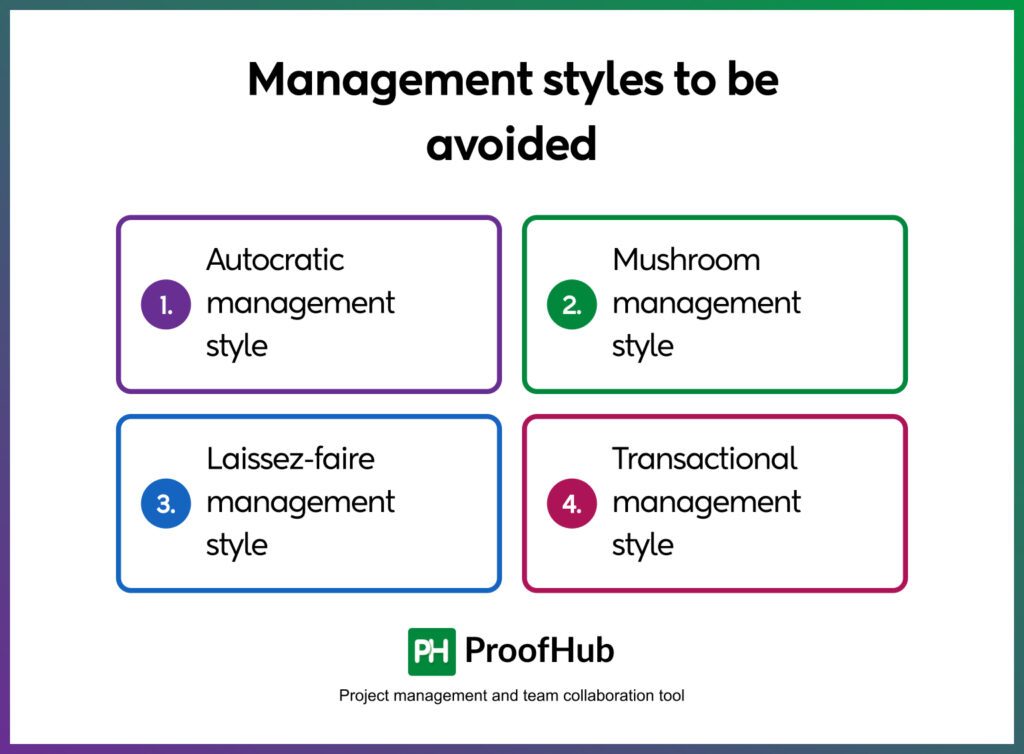Incorporating the best management styles into your leadership has become quintessential in today’s highly competitive business environment.
As a leader of the pack, when it comes to managing people, tasks, projects, and situations, you are expected to put your best foot forward by using a variety of management styles.
As the Chief Marketing Officer at ProofHub, I have learned from years of experience that a manager cannot utilize a single management style every time to efficiently manage different individuals and situations.
Being versatile is the key to today’s dynamic work environment.
After learning the best management styles, I’ve been able to handle different situations optimally.
In this article, we will have a look at the most favored management styles (including ones that should be avoided), and how to determine which management style is apt for you.
Read right till the end to get the maximum value out of this well-researched, informational article.
What is a management style
Management style can be defined as an approach in which a manager practices different methods to accomplish objectives within the organization.
A management style is a way in which a manager creates a plan to achieve set goals through the smart management of human resources and situations at hand.”
As mentioned earlier, you might use a variety of management styles according to the given situation.
Managerial styles can be autocratic as well as permissive, and each style has its unique set of advantages.
Let’s take a look at why management style is a vital cog in the wheel of inspiring and successful leadership.
Why management style is important for successful leadership
As your business starts to grow, you implement several steps and procedures to make sure your business stays on the right track.
At this juncture, a strong management style can prove to be crucial for driving your business forward and taking it to the next level.
As a responsible and accountable manager, you must realize the impact your management style can make on your team members’ overall performance, self-confidence, and ultimate success.
Remember, depending on your approach, the results could be either positive or negative.
Want to know more about how your management style holds the key to not only yours but your team and organizational success?
Read on to know more about it.
- When you learn and implement a variety of management styles, you won’t have to rely on temporary management trends that come and go. Rather, you can use a specific management style to deal with a specific situation to find a long-term solution.
- Using the best management styles empowers you to adapt to certain “sensitive” situations in a better way. For example, critical deadlines, emergencies, and organizational strategies. These situations call for a direct management policy that can only be tackled with a strong management style.
- The right management style deeply contributes to improving employee engagement. Engaged employees are more likely to exhibit better performance and increased output. They experience a greater degree of comfort with the senior management which positively impacts employee retention.
- Each management style offers its own unique set of skills. When you choose a style that befits your personality, your team’s character, and your organization, you are in a better position to focus on exercising your strengths and improving your weaknesses.
6 best management styles preferred by extraordinary managers
As managers, it’s our responsibility to create high-performing teams that not only deliver great results but also add a great deal of value to the organization through their ethical conduct and discipline.
We have a huge role to play in helping people make the most of their inherent talent and skills and steer their combined efforts towards a common organizational objective or goal.
That said, you need to identify and zero in on a management style that you think can work for you to drive success as a leader.
Of course, any manager worth their salt would prefer to use the best management style.
Given below are some management styles that are preferred by the best managers across various industries. Surely, you would want to fall into that category, wouldn’t you?

Let’s have a look at them.
1. Results-based management style
Leaders who practice results-based management styles emphasize the results and pay less attention to the process. In other words, you are less bothered about how to get things done and more concerned about getting things done on time with minimal errors.
Right from the start, these leaders know what goals their organization must achieve. Keeping this in mind, they allocate the right resources and assign the right tasks to the right people.
Since a results-based management style sets clear expectations, this approach results in the boosted morale of employees, improved loyalty, and better engagement levels. The only thing that matters is results!
Example- The automotive sector often adopts this approach where car dealerships set the target to their marketing and sales teams to sell a certain number of vehicles in a particular month. This gives team managers a clear idea of what results they are expected to achieve.
2. Visionary management style
One of the best management styles that is widely practiced by great leaders who have a vision. They can foresee what is likely to work in the future (and what might not).
Visionary leaders do not take part in the day-to-day operations of their teams. Rather, they concentrate on conveying the organization’s purpose and vision to the team and let them work according to their style.
Visionary managers will only check in to ascertain their teams are productive, and on the right track, or to discuss useful insights.
A visionary leader keeps employees united and encourages them while ensuring that the team does not reel under the pressure of work.
A visionary management style is ideal for divided teams whom you want to unite to achieve a common goal. Additionally, it can also work for seasoned teams who do not require round-the-clock supervision.
Example- During the 2008 economic recession, both Tesla and SpaceX were facing closure. However, Elon Musk’s risk-taking ability and vision ensured both companies not only survived the recession but also succeeded.
3. Democratic management style
The number 3 on the list of the best management styles is the democratic management style. As the term suggests, in a democratic management style the control is vested in the hands of employees.
They are given a free hand to participate in the decision-making process by their managers because the latter understands that employees are the key to a team’s success.
Even though managers following a democratic management style ultimately make all major decisions, their teams heavily influence the final decision taken. Giving employees such authority can do wonders for their morale, self-esteem, and performance at work besides building a healthy, trusting relationship between the two.
Democratic management style also makes it easier for managers to persuade their employees to support a team’s vision and keep everyone on the same page.
Example- A leading advanced healthcare research facility, the Mayo Clinic, thrives on democratic leadership values. The healthcare and research facility attracts some of the best industry talent because they can work collaboratively among peers on democratic teams.
4. Pacesetting management style
The pacesetting management style focuses on leading from the front. Yes, as a leader of the pack, the buck stops with you. Managers following this best management style call all the shots i.e. set instructions, set the workspace, and expect your employees to deliver increased output consistently.
Generally, pacesetting revolves around setting high standards for the teams so that they can give their best efforts to hit bigger goals. This management style might be tough for employees as they’ll have to work harder to reach and maintain the set pace of work.
However, a smart and skilled manager will set a pace that his/her team is very much capable of hitting. That said, you will need to make sure that your team members are high on motivation and zeal to try and match the pace you’ve set for them.
Pacesetting management style sounds intense and you set the tempo for your team.
Example- Jack Welch, the former CEO of General Electric, effectively led the company for twenty years. He earned the nickname “Neutron Jack” for setting a rigorous work pace and cutting down 25% of the company’s jobs over four years.
5. Transformational management style
Leaders following a transformational management style are innovators. They firmly believe that change and growth are the only way to stay ahead of the competition, so they do not let their employees rest within their comfort zone.
Rather, their managers continuously push them to deliver more, thus making them realize their true potential.
Transformational management style motivates employees to work harder and set higher standards for themselves and the rest of the team. The benefits of this management style are too good to be ignored by managers and organizations.
Employees led by transformational managers are more committed and satisfied. This leads to better mutual understanding and building trust within the team. It fosters a congenial working environment with clear values, goals, and standards.
Example- Henry Ross Perot, the American business magnate, billionaire, and philanthropist, started Electric Data Systems, a company that built and serviced computer systems for customers. He used the element of the “personal touch” of leadership to great effect along with strong decision-making and risk-taking abilities.
6. Participative management style
It’s evident from the term participative that this management style encompasses both managers and employees as active participants in the decision-making process.
Management invites employees to come up with ideas, thoughts, and opinions and collaborates with staff to make decisions before the organization executes them.
A participative management style falls amongst the best management styles. It revolves around the notion of leaders who understand the significance of human intellect and strong employer-employee relationships.
Leaders who adopt participative management seek to invite and embrace ideas and inputs from other people within the organization.
A participative leader is closer to his/her team than any other type of leader. It is because they believe in treating their employees as a close-knit group in place of taking a standard, formal approach, which can lead to dissatisfaction among employees.
Example- British Airways is a great example of a participatory management style. During the economic recession, employees’ suggestions helped the business to bring down its annual cost of operations by a whopping 4.5 million pounds. The company would have taken huge losses if it were not for adopting employees’ suggestions.
What are some management styles to be avoided?
Now that you’ve gone through some of the best management styles adopted by leaders across the globe, it’s time to learn about some of them you should be staying away from.
These avoidable management styles have more cons to them than their pros. Read on to know why you should be staying away from them.

1. Autocratic management style
This one does not hold a candle to six of the best management styles mentioned earlier in the article. Opposite to the democratic management style, the autocratic management style means that managers have the ultimate power and strong authority in decision-making, and expect their employees to follow instructions and rules without any questions. This management style is also referred to as the authoritarian management style.
Even though I believe that competent managers should make important decisions, it’s equally important to take the team into confidence in certain situations. After all, it’s your team who will get the work done and if they’re not happy with things then it’s unlikely that you will achieve set goals.
Ignoring their ideas, feedback, opinions, or concerns could backfire in the form of high employee turnover rates, low morale, and low productivity. I would not like my team to feel undervalued time and again, do you?
Example- Leona Helmsley, the ex-real estate broker and Hotelier, was famous for harsh and authoritarian leadership within the Helmsley hotel empire. Helmsley was often harsh and insensitive in treating those working within the chain.
2. Mushroom management style
Another management style that good managers should avoid is the mushroom style of team management. Why? Simply because managers practicing this management style have severe communication issues. And we all know how crucial quick and seamless communication is to the team’s as well as organizational success.
Right communication channels are not utilized because the leaders do not deem it necessary to communicate the organization’s policies to their teams. The mushroom management style is probably the most unhealthy management style, and I am not exaggerating it.
Just like the caps of mushrooms, the managers tend to keep the employees under a shade where no goal is clear, and no purpose is in sight. Not only does this management style lead to a lack of transparency at the workplace, but it also leads to an unhealthy, not to mention, hateful work environment.
Example- When the Titanic hit an iceberg, the captain did not inform most of the crewmen about the severity of the situation. Only a handful of the crew members were aware that the ship was going to sink. The captain tried to conceal the news and tried to act on his own, which resulted in chaos and tragedy.
3. Laissez-faire management style
Laissez-faire managers monitor their team’s activities as other managers do. However, when it comes to proactive management, these managers are completely aloof. They expect their teams to raise the bar but would not do anything to help employees reach a certain target or goal.
How can I expect my team to respect me and follow my instructions when I am guilty of not checking in with them about work progress or any potential problems they are facing?
Most of the time, employees led by laissez-faire managers barely have any guidance or vision. Employees might feel pulled in every direction, so they can’t accomplish anything worthwhile. This is the least desirable and least effective management style because, without any guidance or vision, most employees feel neglected.
Example- Warren Buffet, an American investor, business tycoon, philanthropist, and the chairman and CEO of Berkshire Hathaway, prefers to hire people who can perform their tasks creatively without taking his help.
4. Transactional management style
The transactional management style involves using incentives and rewards (bonuses and stock options) to motivate employees so they can carry out their managers’ commands with compliance as well as sportsmanship.
Even though it can be a good idea for managers to adopt a transactional management style to encourage employees, psychological research shows that extrinsic motivation can wear off in the long term and might diminish your employee’s intrinsic motivation to succeed at work.
Example- Bill Gates is a good example of a transactional management style. Bill Gates frequently checks in on operations and ensures that things are going as planned. He wants to see nothing falling through the cracks
What is your best management style?
After reading about six of the best management styles, likely, you have identified with one particular management style more than others. However, that does not mean you have to stick to it!
As mentioned earlier, managers need to be versatile to handle different situations at work. In this context, you should also consider what management style best suits your team members. For example, some will work better under a visionary and democratic style while others will thrive with a participative approach.
Smart leaders realize that there’s no one-size-fits-all approach to management, and they cleverly use different styles to get the best out of their employees.
Your preferred management style needs to align with:
- Your personality, working style, and skillset
- Your team’s requirements
- Your team’s skill levels
- The work culture of your organization
- Organizational policies and priorities
“Are you tired of figuring out who assigned what task to whom? Sign up for ProofHub TODAY and switch to smart task management!”
The takeaway
Management can be an exceptionally turbulent job. The most well-performing managers across various industry verticals understand that you need to utilize different managerial styles to tackle different scenarios, different clients, and different projects.
Using one or more of the best management styles, you can manage your teams better and lead your workforce to success. I sincerely hope that this article has helped you to identify the best management style and incorporate its unique traits to deliver astonishing results.
Related articles:

